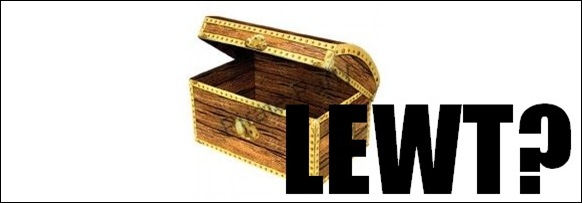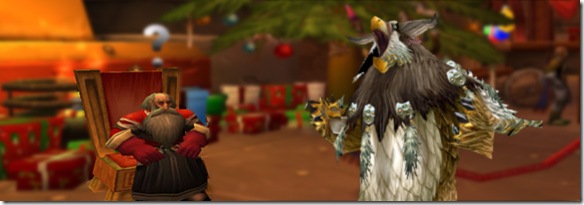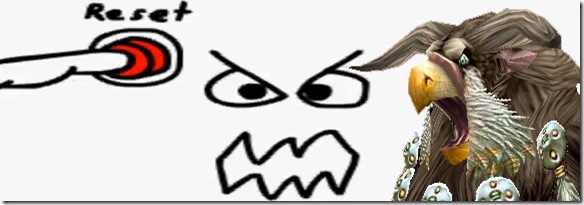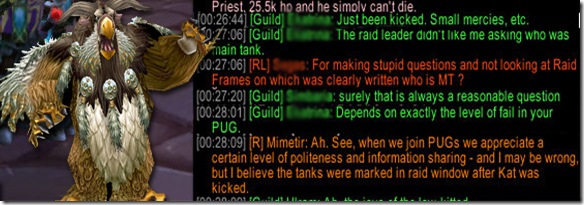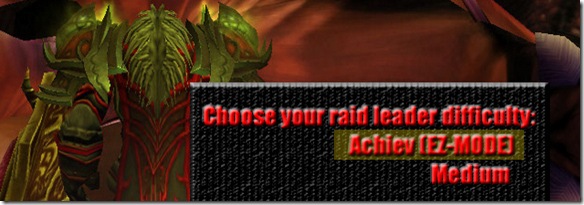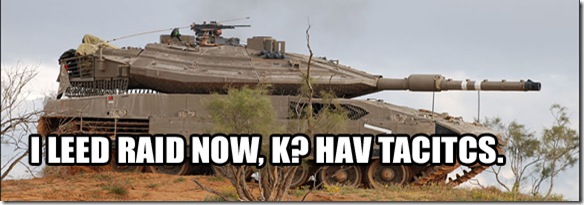The other week, as a gift to you from us, we each offered to write and discuss a topic of your choice. Here’s what we came up with!
What do you want for Winter Veil? You want to wrap your boomkin snugly in an Ancient Polar Bear Hide or keep your holydin’s toes toasty in a pair of Mudslide Boots? Well you can’t have it.
Bah, humbug.
Patch 3.3 has hit just in time for the winter holidays – a time when a lot of us players manage to squeeze in extra time being a hero and getting shiny treasures. 3.3 brought a sled-load of new toys to play with in game, including the new dungeon finder system and its potential for random group member loot drama. As a result while using the dungeon finder we are all limited to needing only on items of our class’ armour type. You’re a paladin? You roll on plate. Plate, y’hear, no cloth for your healing set. Certainly no leather for you DPS warrior types! It’s not exactly ideal for anyone gearing up.
It’s the Winter Veil equivalent of a pair of socks: practical, but not exactly what you wanted.
What, I hear you cry? The 3.3 patch notes describe it best;
“Need Before Greed will now recognize gear appropriate for a class in three ways: the class must be able to equip the item, pure melee will be unable to roll on spell power items, and classes are limited to their dominant armor type (ex. paladins for plate). All items will still be available via Greed rolls as well as the new Disenchant option should no member be able to use the item.”
I can see the practical sense in this. It removes some arguments about loot before they’ve even begun. The rogue won’t get miffed at the shaman needing on and winning leather melee gear because the shaman just can’t. Likewise, the death knight who is prone to shiny object moments and rolls on spell power items accidentally – just can’t, and won’t have to explain himself to pitchfork wielding casters. Reducing the potential for arguments is a sensible, if slightly cynical, move in a system which promotes meeting random strangers who have no reason to relate to or sympathise with you.
Yet what does that do to your characters? It might be taboo but we all know that paladins do incorporate all types of armour into a healing set, have done since the beginning of the World … of Warcraft. A paladin friend of mine has recently started gearing up for his holy off spec. He would prefer plate items of course, but any type of item with spell power on it is better than healing with defence rating gear. We had the Azure Cloth Bindings drop for us just earlier today – and he couldn’t roll on them. Sure, he’d only have used them as a stop gap until something better and more, well, platey came along. But until then they would have seriously boosted his off spec prospects and none of the actual clothies in the group showed the slightest interest in wanting them anyway.
The only option for my friend, or anyone looking to boost their off spec with drops forbidden by the loot system, is to greed the item and hope that RNG is kind to them and doesn’t shard it for someone else. Or of course to keep running Heroics, waving sadly at these drops, and waiting until they’ve enough badges to get the badge equivalents.
Take another situation. You’re a tree who is so bored you’ve taken root in the middle of Dalaran and didn’t bat a branch when children – sorry, gnomes – covered you in tinsel and shiny lights two weeks ago. You want to do something different. Something fun. You’ve had the cookie-cutter spec for a while, got the gear, done everything you want to do. So you start playing around building your own spec – something hybrid that allows you to heal and CC or DPS without changing spec. Yes, healing and DPS – you know it happens, especially when people are bored. And Heroics aren’t exhilarating, let’s face it.
Say you want your druid to be able to do all that in one spec – well then, you’ll need to play around a bit with your stat distribution and probably get some new armour. Would you like some hit with that? How about a new party hat – the cloth Sightless Crown of Ulmaas would do the job. Oh wait – you’re a druid – you can’t roll on cloth, even if the rest of the party consists of three death knights and a warrior.
There are still a couple of loopholes, too. To my knowledge death knights and druids are able to roll on loot with block rating on it. A pointless stat to them, but perhaps your death knight tank decides that he is so desperate for something to upgrade from his blue helm that when Second Helm of the Executioner drops it is a must have even though the itemization is aimed more at the group’s paladin who is only tank as off spec.
Well, gratz to the death knight for the upgrade – but it’s only a minor victory for him, and leaves both him and the paladin a bit cold. Should Blizzard further tinker with the need before greed system? Perhaps add class specific tooltips – “classes: paladin, warrior” – to the aforementioned Executioner’s helm. Similarly for every item, and a filter that only allows the specified classes to roll on items with stats meant for them.
If this came into play then it would likely automatically further restrict itemization choices for players. Every rogue of the same playing level would look the same. Every healing priest would be in the same dress, every restoration shaman would have identical mail shoulders for restoration shamans. That Winter Veil tree druid in Dalaran would have even less freedom to play around with his spec and try new things. But at the same time – everyone would get loot cookie cuttered to cater the ‘correct’ stats to their spec.
Say that our off spec tank paladin from earlier wants the correct stats – for his protection off spec – and rolls need on the Executioner’s helm against the death knight tank. Whatever his reason, I’d bet the death knight isn’t impressed with him rolling for his off spec. Would you be, if someone else rolled against your main spec items? We’ve all seen it. Perhaps the need before greed system should take specs into account. A priest is healing in a random dungeon? Right, says the loot system. He can’t roll on items with hit on them like Bracer of Worn Molars, under any circumstances. On the up side he won’t be able to ninja, on the down side he won’t be able to prove he’s trustworthy or improve his shadow kit if everyone else passes on the toothy armguards there.
These are ridiculous ideas, I hear you cry. They’ll never happen! Maybe you’re right, or maybe they’ll happen at some point. I’m just saying that the need before greed system is already restrictive – unnecessarily so, perhaps. I for one am perfectly happy with a holydin rolling on cloth items so long as no clothies need the item, and so preventing holydins from doing it seems a potential waste of an item. It may be a slippery slope we find ourselves on in the name of wrapping classes up in their own specialised cotton wool.
What do you think? Is the need before greed system protecting us just the right amount in random dungeons at the moment – should it be more or less protective? Are you getting infuriated trying to gear up your new fury warrior? Is all this an argument to make a premade group so there aren’t limitations on loot?
